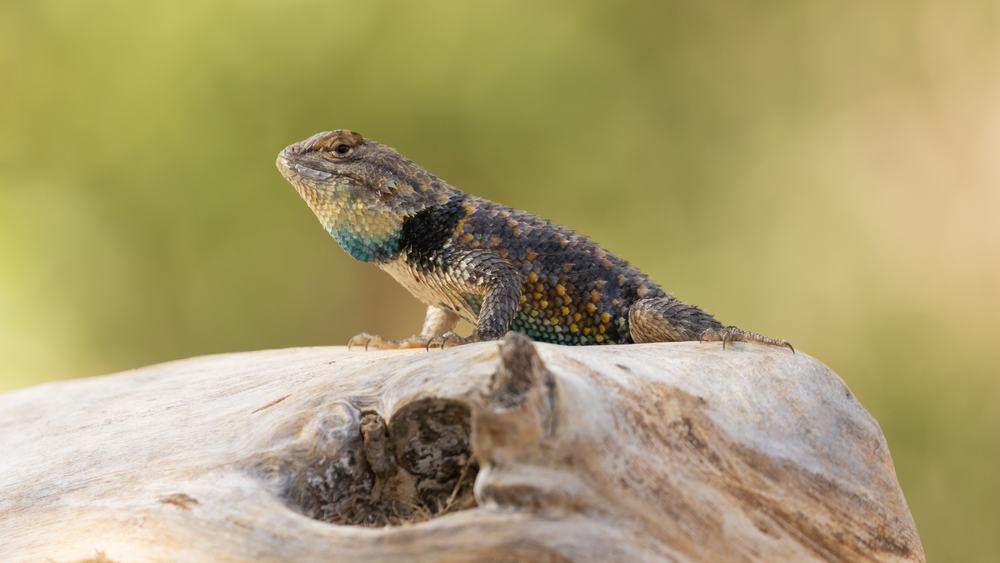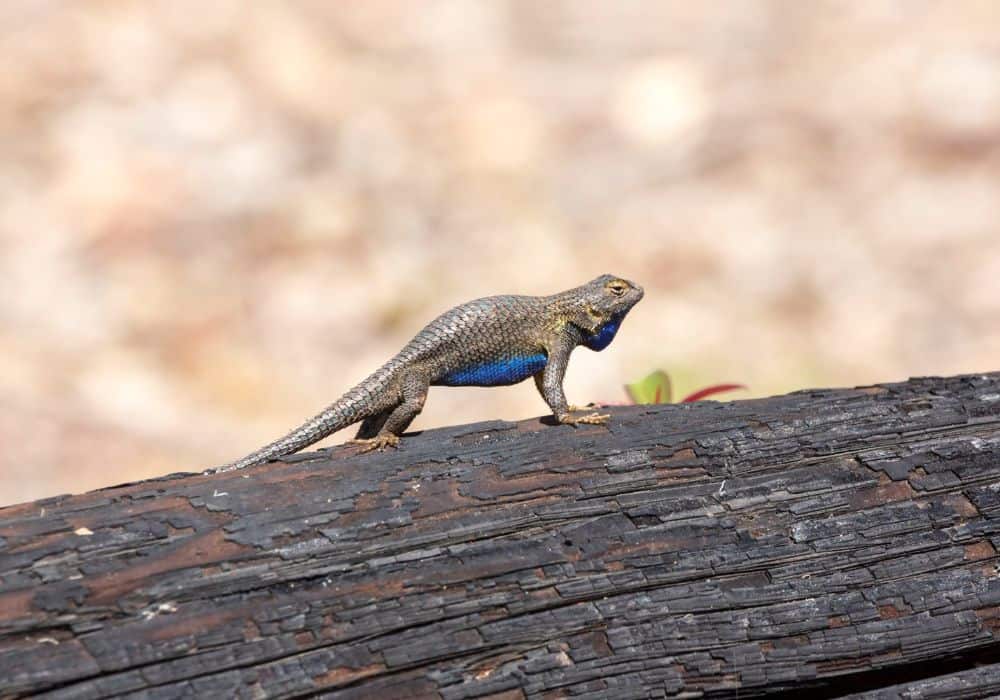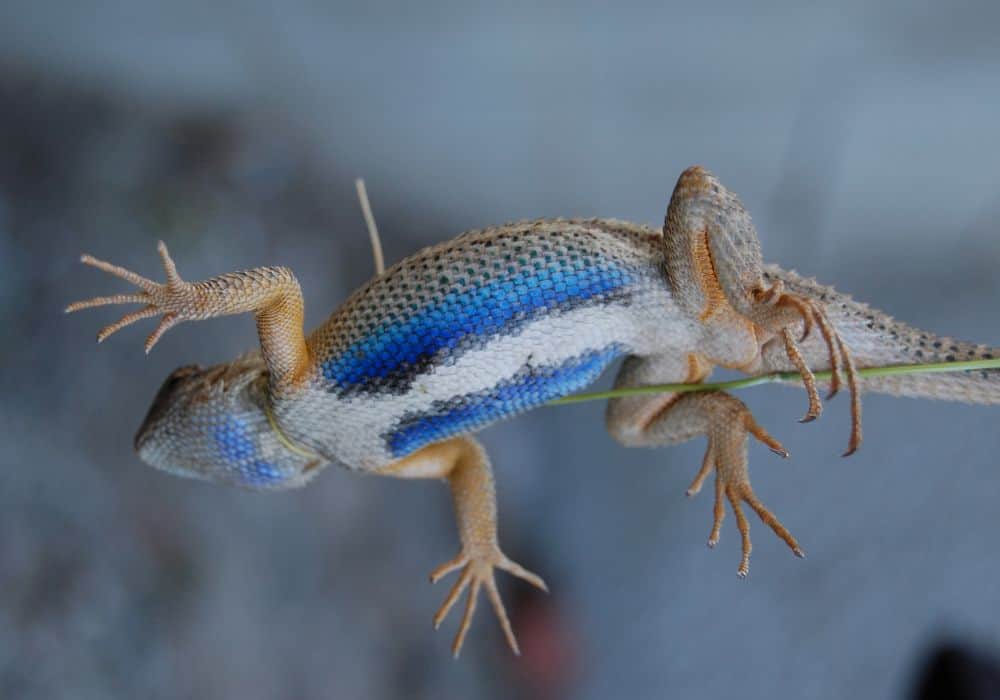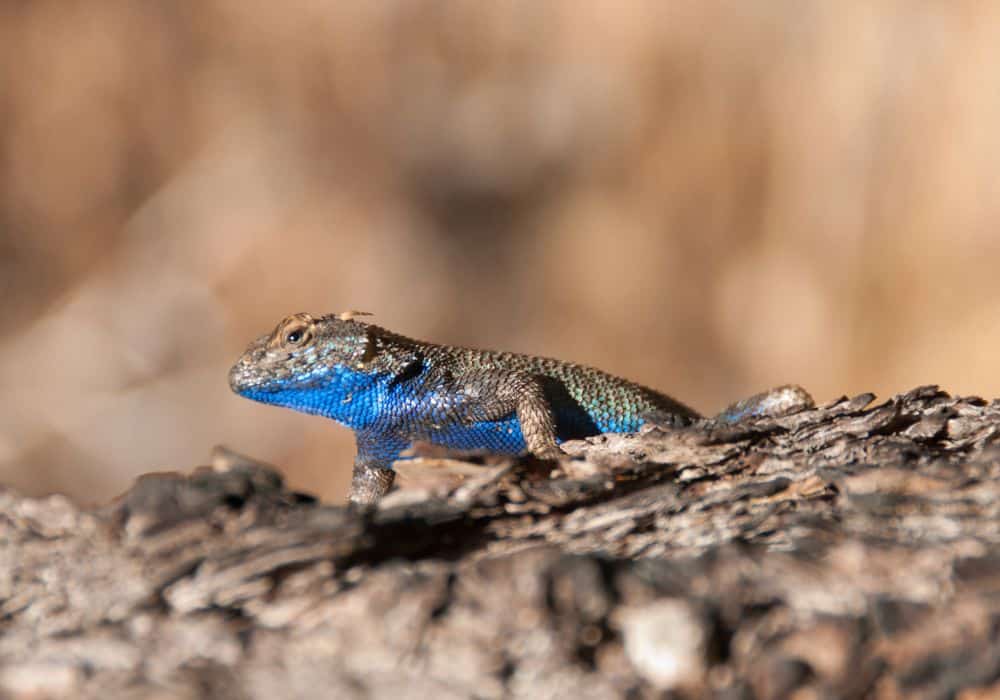The popular western fence lizard, also known as the blue belly lizard, inhibits Idaho, California, Nevada, Oregon, Arizona, Utah, Washington, Northern Mexico, and other surrounding areas.
They’re small grayish-brown lizards with shiny blue scales on their belly, hence their naming. Moreover, they make excellent pets because they’re low maintenance.
So, if you’re interested in owning a blue belly lizard, read on, as I will share care tips and answer all your questions associated with blue belly lizards.
Facts about Blue Belly Lizard
Most blue-belly lizards have blackish-brown, gray, or brown bodies; however, what’s unique about these lizards is their belly.
The edges of their bellies have bright blue markings. That’s why they’re called “blue belly lizards.”
However, the reason why their belly is blue is unknown. What’s known is that males have a more vivid and striking blue stomach than females.
Typically, blue belly lizards reside in many landscapes, including sagebrush, rugged canyons, and meadows; they don’t like damp and woody areas.
They’re also known for their great climbing skills and have a body length of between 2.2 and 3.4 inches; adult blue belly lizards can reach up to 6 inches in length.
Is a Blue Belly Lizard Poisonous?
Blue belly lizards aren’t poisonous but can land a painful bite, so consider that when handling your blue belly lizard.
Will Blue Belly Lizards Cure Lyme Disease?
Apparently, blue belly lizards contain certain proteins in their blood that can destroy borrelia burgdorferi, the bacteria that causes Lyme disease.
Moreover, did you know that blue belly lizards change color to disguise themselves and absorb the sun’s warmth better?
People often see lizards sunning in the middle of the streets or enjoying rocks and fences. They also stay in areas near water so that they can hydrate regularly.
Now, let’s learn more about the diet of these unique creatures.
What Do Blue Belly Lizards Eat?
Typically, blue belly lizards eat ants, worms, spiders, and crickets. Simply put, they consume smaller bugs, so they’re carnivores and insectivores.
A study by William H. Clark for Herpetologica suggests that blue belly lizards prefer bugs over plants or animals since the stomachs they explored contained nothing but different bugs.
However, this isn’t new; many other lizards and reptiles only eat bugs.
That’s why you can see blue belly lizards in your garden, especially if you reside in a region that also gets a lot of sunlight during the day.
You can’t confuse blue belly lizards with other lizards because they’re pretty unique with their blue scales around their face and a larger swathe of blue on their stomach and front.
If you have a blue belly lizard at home or want one in the future, here’s a list of food they consume:
- Worms
- Spiders
- Earthworms
- Grasshoppers
- Ladybugs
- Mealworms
- Beetles
- Larvae
- Aphids
- Wasps
- Ants
No matter the age or size of the blue belly lizard, they eat bugs; however, scientists suspect that as they get older, they eat large bugs.
Studies say older blue belly lizards leave smaller insects and bugs for smaller ones, especially young ones. Or those still developing in their first years.
How Often and How Much Do Blue Belly Lizards Eat?
Typically, blue belly lizards have irregular meals about 3-4 times a week. However, most blue belly lizard owners feed their pets every other day.
You can quickly determine your lizard’s food portions by providing food and closely observing. The amount your pet eats in the first five minutes is how much they need every second day.
Studies also determined that their diet consists of about 97% insects. The other 3% was mostly debris. So, follow their advice and only feed your lizard insects.
Important note: These lizards don’t need daily feeding.
How Do You Take Care of a Blue Lizard?
Blue belly lizards make great pets. However, you should take proper care of your blue belly lizard by providing a large enough habitat, water, a heat lamp, and food (insects and bugs).
Here’s a short guide on properly taking care of your lizard.
Pick the Right Aquarium
You will need a 10-gallon tank with a glass cover for smaller lizards and a 20-gallon tank for larger ones.
Moreover, place your tank in the sun because lizards love sunbathing. If necessary, provide partial shade; intense heat can dry out your lizard’s habitat.
The tank’s location should be about 90 degrees Fahrenheit.
Additionally, it would be best if you misted your lizard’s enclosure one or twice a day to keep the optimum humidity level.
Blue belly lizards need UV rays and UVB and UVA radiation. You can provide these things by installing a 75-watt bulb, but keep the distance between the light and tank at about 4 inches.
Lastly, lizards also like sand as they dig and bury themselves when resting, so you should provide unamended soil, sand, or cypress mulch.
Extra tip: I highly suggest adding branches or twigs in the aquarium, as blue belly lizards love climbing.
Maintain the Tank Regularly
It would be best if you cleaned the enclosure occasionally (2-3 weeks). Replace the sand once a week, remove dead plants and leaves, and replace their water daily.
Place your lizard in another tank while you clean their regular tank so they can stay safe.
You can clean your lizard’s enclosure with clean hot water and dish soap. Once it’s cleaned, you can sanitize your décor and aquarium with a 10% bleach solution, then rinse with hot water and let it air dry.
Take Care of the Temperature
As I already stated, lizards love sunbathing. They’re cold-blooded animals, so they must lay under the sun and maintain their body temperature.
The place under the heat lamp should stay at 90 degrees Fahrenheit, while the rest of the tank be between 75 and 85 degrees, but not under 65 degrees at night.
You can purchase a good reptile heat lamp at local pet stores.
They usually come with UVA, UVB, and UV rays; however, if yours doesn’t provide UV rays, you can add a second UV lamp about 4 inches from your aquarium.
Provide the Proper Diet
Out in nature, blue belly lizards consume a broad selection of insects and bugs. For smaller lizards, you will need baby crickets and ants.
The appetite of smaller lizards increases as they grow, so they will eat larger insects and bugs: spiders, waxworms, earthworms, bigger-sized crickets, and grasshoppers once they become adults.
You can find lizard food in local pet stores; if you’re worried about feeding your blue belly lizard, ask your exotic-animal vet for advice.
How Do You Take Care of Multiple Baby Blue Belly Lizards?
If you have multiple baby blue belly lizards, keep males apart, as they’re territorial animals, so keeping them together can result in fights and injuries. To prevent this, keep your male lizards in separate enclosures.
You can also place two females with one male if you have a larger aquarium. They can all fit in a 20-gallon tank. There’s also a good chance they will breed in captivity, so make sure there’s space for laying eggs inside the tank.
How Do You Take Care of a Baby Lizard?
The caring process for a baby lizard is the same as for adult lizards.
Cover the bottom of the tank with about 1-inch of dirt or sand. On top of the sand or dirt, place wood, rocks, sticks, or ledges where your lizard can freely climb.
Place a small dish filled with water inside the aquarium, but note that they might not consume it if they get enough water from their food.
Lastly, make a hiding spot for your baby lizard and add food. You can sprinkle ants, baby crickets, beetles, and small insects.
Additionally, cover the food with calcium powder, so your baby lizard can absorb the calcium. You can find calcium powder at your local pet store.
Important note: You should feed your baby blue belly lizard small portions of food. The jaws of smaller lizards can’t handle larger things like maggots or worms.
What Are Blue Belly Lizards’ Predators?
Blue belly lizards aren’t just predators. They’re also prey. Some of the predators of blue belly lizards include snakes, shrews, hawks, and other birds of prey.
Blue belly lizards’ main cause of death is predation, especially when sunbathing on stones and faces where predators can easily determine their whereabouts.
Conclusion
In a nutshell, blue belly lizards make great pets. They’re low-maintenance, have a simple diet, and lead a simple lifestyle.
In the wild, they live a short life, as they’re preyed upon by many other animals, but in captivity, they can live up to 5 years if cared for properly.
Remember that most wild lizards might need time and patience to adapt to their tank and owners. However, if you have the time, patience, and enthusiasm to care for it, go for it, and you won’t regret your decision.



